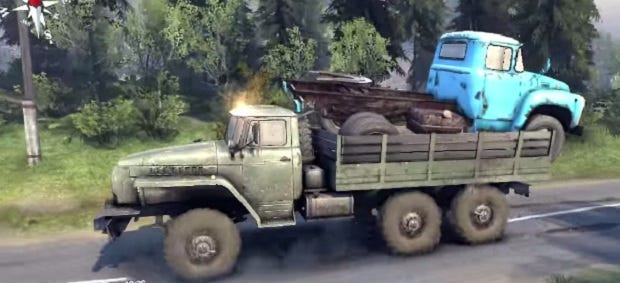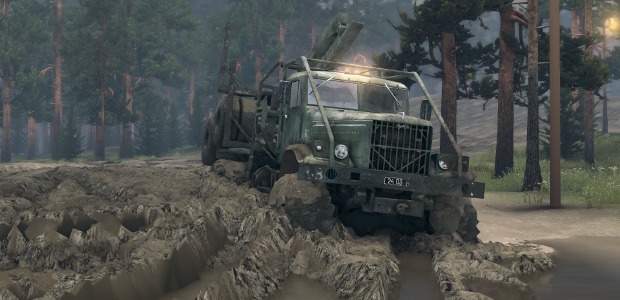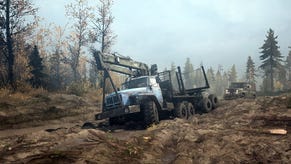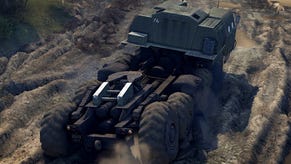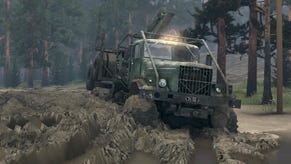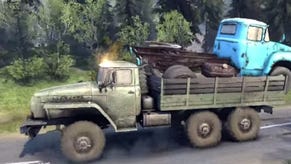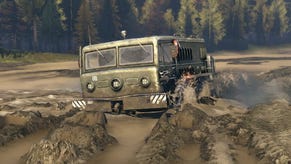Wot I Think: Spintires
Surface tensions
I'm stuck in a puddle and I can't get out. Every attempt to move forward only serves to send me deeper into the hole I've made for myself, and every attempt to reverse causes my vehicle to scream, splutter and stall. It all ends in tears and treadmarks, tires bald and fuel gauge needling toward oblivion. The track has become a battlefield and I'm desperately in need of assistance. Time to call in the big guns and tow my brokedown truck back to base. I'm battered, bruised and covered in filth. In Spintires, my earnest efforts cause me to dig my own grave, down in the dirt and the filth. Here's wot I think.
Spintires has one superb trick in its trunk and it pulls it off exceptionally well. Is that enough?
That one trick is exploring the complexity of mud. No game has ever modelled the slippery, unctuous material so expertly. Driving the industrial vehicles on the game’s five maps is an astounding exercise in the importance of surfaces. That’s the key word – ‘surfaces’. Spintires may be an amusing and occasionally frustrating game about machinery and mud, but from a design perspective, it’s the treatment of surfaces that deserves attention.
For those desperate to roll in the morning mud, I’ll cut to the chase. The extremely laborious chase in which every vehicle stalls repeatedly while digging its own grave. Spintires has the best malleable terrain that I’ve ever seen in a driving game. It chops up, tires carve it and the weight of every part of a vehicle leave imprints on the world. The engine is glorious but the chassis is functional at best. There’s enough content to eat up many hours but it’s all of the same type – go here, fetch that, bring it to another place. If you’re capable of making your own stories within the framework of an industrial vehicular traction adventure, then Spintires will satisfy your soul.
It’s a frustrating game to write about because I keep jotting down paragraphs that fall into the ‘I wish this game was…’ trap. That’s because the technical achievement lends itself to flights of fancy rather than because the design is flawed or particularly hollow. Imagine this level of deformation applied to trench warfare. Imagine rally cars chewing up tracks as they scrambled and slid. Add Spintires’ deformation to the already impressive Next Car Game and you’d have the greatest combat racing game ever made.
How’s about a Panzer simulator or a gravity-bound three dimensional Scorched Earth?
To understand how satisfying and radical the attention to what happens at the point of contact between wheel and ground is, it’s important to understand how surfaces have been treated over the decades of game design. This, courtesy of your thrill-a-minute RPS periodical, is a non-chronological analysis. Of surfaces. In games. Hold onto your hats.
We begin with platformers. Platforms are surfaces in a roundabout sort of way, so it’d be reasonable to expect contact between the player and the floor to be of utmost importance. More often than not, platforms are simply structures to support characters though – they’re ledges and their specifics only tend to matter in regards to placement.
There are complications from time to time. Everyone who has ever played a platform game will have come across a patch of ice, causing characters to slip and slide, and there are often tell-tale cracks and clouds of dust to signify platforms that will crumble after a touch. These are binary switches though. A platform, or area of a platform, is of one type or another and its behaviour is entirely predictable. The earliest and strongest entries in the Sonic series played with gradients and momentum in a way that has proved tricky to replicate, at least with the same degree of tight control and credible friction.
If Spintires were a platform game, surfaces would bleed into one another. Collapsible platforms would crumble and collapse inch by inch, and the debris would clutter the spaces below. Ice would crack given the application of enough force and it would be possible to prevent completion of a level by applying pressure in the wrong place at the wrong time. Mass would matter and every jump would have the potential to alter the playfield.
In Spintires’ world, feats are measured by inches of control rather than miles per hour, and the terrain churns and deforms as vehicles traverse it. It’s a game in which overapplication of the throttle can doom the driver. It’s verbs are not overtake, drift and vroom, but churn, grind and calculate. The latter is perhaps the most important. For all of that it is made of mess and mud, Spintires is a game of precision and care. To traverse the changing angles of the roughest terrain, every nudge of wheel and pedal must be perfectly timed and measured.
One of the biggest advances that I remember in the surface world came with the destructible scenery of Red Faction. Guerrilla built on the idea, with its collapsible buildings, but the principle remains the same. The ground is divided into types of material – the primary foes being mud and gravel – but they’re not as cleanly defined as history leads us to expect. Take stealth games, where some areas are marked with vines for climbing and some are visibly noisier underfoot.
Spintires muddies the boundaries. Certain elements of the world are reactive, altering on impact. It’s similar to Guerilla in that the deformable maps behave credibly, reacting to input unpredictably and forcing the player to think about the effects of their actions.
Spintires has a very silly trailer but it’s a serious game. It’s probable that the game reached the top of the Steam charts on the day of release because people found the notion of a lumber collection simulator starring off-road Soviet vehicles amusing. The game certainly facilitates farce but it isn’t designed around comedy set pieces. If you have any intention of exploring the maps, and unlocking vehicles and locations in order to carry out major logging operations, you’ll need to be as focused as an aircraft pilot attempting a landing on a carrier.
I’ve allowed my imagination to carry me through the eventual tedium of logging, as I often do when playing this sort of sim. I set myself challenges – heading from point A to point B within a self-imposed time limit, pretending that my enemies are hunting for me in the wilds, or attempting to recreate The Wages Of Fear while praying for explosive mods. I’m back to those fanciful imaginings I swore I’d try to avoid.
Spintires is as rugged and (in)efficient as the vehicles that struggle across its harsh landscapes. It’s drama and tension are found in puddles rather than lakes, and its beauty is in the dimples at a roadside rather than a majestic mountain. The controls are precise and tight, and the speed is slow and gruelling. Many driving games bring back memories of Scalextric or playground Micro Machines tournaments, but Spintires is more like driving a Tonka Truck or Big Action Dig ‘n' Ride through a flooded sandpit.
Within the apparent simplicity of its fetch quest structure there is space for navigation, exploration and nail-biting rescues. Patience is required but the pay-off is often amusing and occasionally thrilling. Thanks to the detailed deterioration provided by the engine, it's unlike anything else. Despite the apparent complexity of its vehicles, it's also an accessible game, easily controlled with mouse and keyboard or joypad (haven't tried a wheel). Where the controls are a struggle, they're intended to be and the fight is with the terrain rather than the interface.
It’s a game capable of sublime nonsense, as vehicles attempt to entomb themselves on lonely hillsides, but Spintires is also a fine simulator. There are a great many games with that word, ‘simulator’, in some way attempting to justify their drab activities and the mundane implementation of those activities. Spintires will have you spending an evening trying to edge a busted up old vehicle out of a watery ditch, but it does so with a fair amount of style and a truckload of savvy. The camera is a bit shite though.
